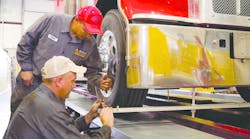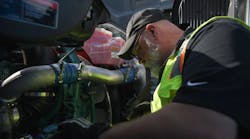Good spare parts inventory management is essential for a fleet’s operational reliability and equipment uptime. Prolonged vehicle downtime and reduced technician and shop productivity due to out-of-stock or incorrect parts can cost an organization valuable time and money.
This can be avoided, however, with processes and systems that:
- Effectively monitor and track spare parts.
- Ensure that parts are appropriately stored and treated.
- Allow maintenance operations to easily identify and access required parts.
Surprisingly, spare parts inventory management is frequently overlooked as a contributor to vehicle uptime, and technician and shop productivity. It is not enough to just have parts stockrooms with good shelving, bins and boxes all neatly labeled.
This article will offers some recommendations and guidance for improving spare parts inventory management.
Stockroom Management Questionnaire
The following questionnaire is a useful research tool for ascertaining how well your parts inventory is managed. It is adapted from the work of Don Nyman, in the book Maintenance Planning and Scheduling by Don Nyman and Joel Levitt, and expanded by Life Cycle Engineering.
It is likely that you will not know the answers to all of these questions. Nevertheless, this five-part questionnaire will help you learn about the areas where you may be unsure of the answer.
Part 1. Material Support and Control
1. Purchasing, inventory and stockroom procedures covering stock, spare parts, special purchases and items manufactured in-house are well documented by written instructions that have been effectively distributed. (Check one.)
___ True (1 point) ___ False (0 points)
2. The stockroom is sufficiently stocked to meet day-to-day needs as determined by the following service levels. (Check all that apply.)
□ Insurance spares (100%). (1 point)
□ Standard replacement parts (95%). (1 point)
□ Fasteners and fittings (90%). (1 point)
□ Small tools (90%). (1 point)
□ Maintenance and repair supplies (85%). (1 point)
3. There is a perpetual inventory system in place which actively and systematically records and reports to maintenance, purchasing and accounting for use in the management of inventory. (Check all that apply.)
□ Computerized. (2 points)
□ Manual. (1 point)
□ No system. (0 points)
4. Inventory control practices are effective. (Check all that apply.)
□ Cycle counting is used to preserve reliability of inventory records. (1 point)
□ Control increases with inventory value using ABC categorization. (1 point)
□ Free issue of low-value items, such as fasteners, is effectively integrated. (1 point)
5. Procedures exist for reserving and kiting stock parts for planned jobs. (Check all that apply.)
□ Reservation/allocation. (1 point)
□ Deallocation. (1 point)
□ Kitting or pre-staging. (1 point)
□ Secured staging to avoid “borrowing” from one job for another. (1 point)
□ Critical spare part lists exist for all-important equipment. (1 point)
Total number of all points: ___ out of 16
Part 2. Physical Stockroom
This section of the questionnaire is designed to help you determine:
- Where does stockroom management fit into your organization?
- Is this the best location for the parts for the good of the organization?
1. □ Adequate material handling resources are available to stockrooms to and from work sites. (1 point)
2. □ A two-bin system is utilized by stockrooms to facilitate issues while maintaining control of high-volume, low-cost items. (1 point)
3. Stockroom layout and procedures maximize order fulfillment service and functional efficiency. (Check all that apply.)
□ Parts are identified with stock (computer ID) numbers. (2 points)
□ Stock storage is environmentally controlled as needed. (1 point)
□ If needed, shafts of rotating equipment in stock are regularly rotated to avoid development of bearing flat spots. This activity is controlled by a PM-type revolving file. (1 point)
□ ABC analysis has been applied to the arrangement of stock storage to optimize efficiency of stock retrieval. (1 point)
□ Stock pick lists are arranged to facilitate picking. (1 point)
□ Computer control will accept no more than two storage locations for any one item in any given stockroom. The impact of this policy is to keep inventory from becoming too spread out and impossible to control. (Note: MP2 asset management software allows more than two storage locations. Therefore, award no points). (1 point)
□ QA (quality assurance) inspection is required, in varying degrees, based on criticality, for all materials received for stock or special orders. (1 point)
□ Barcoding or RFID technology is utilized to facilitate tracking of purchase orders, stock requisitions, parts and progress through the receipt/inspection/stocking/issue process. (1 point)
4. □ In central stockrooms, parts are stored randomly to maximize storage density. (1 point)
□ In satellite stockrooms, parts are stored by equipment to facilitate retrieval. (1 point)
□ Cannibalization from a serviceable unit (generally not installed) to another serviceable unit (generally installed) is against established policy. When necessary in an emergency situation, the necessary work orders, stockroom requisitions and/or purchase orders are initiated to restore the cannibalized unit to a serviceable state. (1 point)
5. □ An intelligent part numbering system is utilized. (1 point)
Total number of all points: ___ out of 15
Part 3. Computerization Assessment
1. □ A computerized inventory control system automatically reorders, or issues a requisition that is acted upon in a timely way, when on-hand quantity drops to or below the reorder point. (1 point)
2. □ Maintenance has ready access to up-to-date material and stock information, including part numbers, stock numbers, bin locations, economic order quantities and reorder points.
(Check all that apply.)
□ Computerized. (2 points)
□ Catalogued. (1 point)
□ No ready access. (0 points)
3. □ Bill of material information is cross-referenced by point-of-use. (1 point)
4. □ Attribute scanning on keywords of the description, both short and long, is available to help find the desired item. (1 point)
Total number of all points: ___ out of 6
Part 4. Assessment of Analysis Techniques Used to Understand the Inventory
1. □ Usage records are employed to determine stocking levels, order points and order quantities. (1 point)
2. □ Unit dollar values are readily available and routinely used in planning and work order approval efforts. (1 point)
3. □ Maintenance, purchasing, accounting and the stockroom work together to assure availability of necessary parts, elimination of obsolete parts, adjustment of stocking levels, minimal lost time by technicians, etc. (1 point)
(Check all that apply.)
□ Maintenance is regularly consulted regarding stocking parameters generated by the system. (1 point)
□ Human judgment can override the system on an item-by-item basis. (1 point)
□ Maintenance influences the type and quantity of repair materials to be set up in stock. (1 point)
□ A system exists that flags frequently ordered non-stock parts which must be authorized for stocking. (1 point)
□ Stocking levels, both minimum and maximum, reorder points and order quantities are set up and maintained.
(Check all that apply.)
▪ Automatically. (2 points)
▪ Manually. (1 point)
▪ Not set up. (0 points)
4. □ Inventory categories are defined and segregated when analyzing inventory value and turns. (1 point)
5. □ SIC (Standard Industrial Classification) formula parameters for EOQ (Economic Order Quantity) calculation (carrying cost, purchase order cost, delivery time, etc.) are current and periodically updated. (1 point)
6. □ There is an established insurance/critical spares program containing review provisions. They are protected from discard due to low usage. (1 point)
7. □ An approved work order indicating which cost center to charge is sufficient authorization to withdraw stock materials. (1 point)
Total number of all points: ___ out of 13
Part 5. The Part
1. Support systems for purchasing are effective. (Check all that apply.)
□ Quality performance measures have been established for materials. (1 point)
□ Purchase order tracking is functional. (1 point)
□ A vendor rating system is in place and vendors are aware of their responsibility to provide materials of acceptable quality on time. (1 point)
□ Procedures are in place that alert requisitioners regarding receipt of their materials. (1 point)
□ Buyers are evaluated on the performance of vendors that they select. (1 point)
□ There is an established interface/partnership with vendors to improve material quality, cost, availability and standardization at minimal carrying expense. (1 point)
2. □ Practices and procedures between maintenance and purchasing are clear and effective. (1 point)
(Check all that apply.)
□ Maintenance is allowed to specify individual suppliers when necessary. (1 point)
□ Maintenance is allowed to specify method of shipment when necessary. (1 point)
□ Purchasing reviews any change in original specs with maintenance and/or engineering. Purchasing does not make material or equipment substitutions without consulting technically knowledgeable resources. (1 point)
□ Purchasing routinely, and when requested, follows up on expedited purchase orders. (1 point)
□ There is an effective system for tracking purchase requisitions from generation to receipt by originator. (1 point)
□ The volume of emergency purchase orders is “reasonable.” (1 point)
□ Production is not permitted to purchase direct nor maintain duplicate inventory of unit spares of special parts. (1 point)
□ Maintenance is permitted to purchase direct locally when necessary. (1 point)
□ When appropriate, maintenance is permitted to contract work to local shops with purchasing cooperation. (1 point)
3. □ Blanket and system contracts, and blanket and system orders, are effectively employed to minimize redundant paperwork and administrative effort. (Check all that apply.)
□ Blanket contracts (e.g., repetitive service). (1 point)
□ System contracts (e.g., service contractors negotiated by the purchasing agent). (1 point)
□ Blanket orders (e.g., parts price agreement). (1 point)
□ System orders (e.g., parts costs negotiated by purchasing agent). (1 point)
Total number of all points: ___ out of 20
Point Scores
Once you have completed the questionnaire, you will have an assessment of the current performance of your spare parts inventory operation within the five key areas noted: Material Support and Control, Physical Stockroom, Computerization Assessment, Assessment of Analysis Techniques Used to Understand the Inventory and The Part.
One section at a time, add up the points earned for each question within the section. Compare that number to the total number of that section’s questions.
This comparison will give you an indication of where there are opportunities for improvement in your parts inventory processes and systems.
Joel Levitt is director of projects for Reliabilityweb.com’s Reliability Leadership Institute. Reliabilityweb.com provides the latest reliability and uptime maintenance news and educational information. He is also author of Fleet Maintenance’s Management Column.






